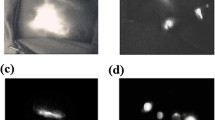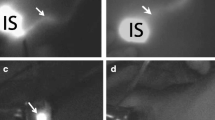Abstract
Purpose
To assess the diagnostic performance of sentinel lymph node (SLN) biopsy using the indocyanine green (ICG) fluorescence method compared with that using the blue dye method, a prospective multicenter study was performed.
Methods
Patients with T1–3 primary breast cancer without clinical lymph node involvement were included in this study. ICG as a fluorescence-emitting source and indigo carmine as blue dye were injected into the subareolar area. Extracted lymph nodes were examined to identify the first, second, and other SLNs. The identified nodes were classified according to the ICG fluorescence signal and blue dye uptake.
Results
Ninety-nine eligible patients were included in this study. The ICG fluorescence method identified an average of 3.4 SLNs (range, 1–8) in 98 of 99 patients (detection rate, 99 %). The number of lymph nodes identified by the fluorescence method was significantly higher than that identified by the blue dye method (p < 0.001). SLN involvement was identified in 20 % (20 of 99) of patients, all of whom tested positive for the first SLN. In 16 patients, complete axillary lymph node dissection (ALND) was performed. In 25 % (4 of 16) of these patients, axillary metastases were identified; however, no axillary involvement was found in 8 patients with only one involved node, which was isolated as the first SLN.
Conclusions
High rate of SLN detection was achieved using the ICG fluorescence method. The first SLN identified by fluorescence imaging provides an exact indication of the axillary status. Therefore, the ICG fluorescence method provides precise information required to avoid unnecessary ALND.
Similar content being viewed by others
References
Schrenk P, Rieger R, Shamiyeh A, et al. Morbidity following sentinel lymph node biopsy versus axillary lymph node dissection for patients with breast carcinoma. Cancer. 2000;88:608–14.
Giuliano AE, Haigh PI, Brennan MB, et al. Prospective observational study of sentinel lymphadenectomy without further axillary dissection in patients with sentinel node-negative breast cancer. J Clin Oncol. 2000;18:2553–9.
Purushotham AD, Upponi S, Klevesath MB, et al. Morbidity after sentinel lymph node biopsy in primary breast cancer: results from a randomized controlled trial. J Clin Oncol. 2005;23:4312–21.
Morton DL, Wen DR, Wong JH, et al. Technical details of intraoperative lymphatic mapping for early stage melanoma. Arch Surg. 1992;127:392–9.
Veronesi U, Paganelli G, Viale G, et al. A randomized comparison of sentinel-node biopsy with routine axillary dissection in breast cancer. N Engl J Med. 2003;349:546–53.
Krag DN, Anderson SJ, Julian TB, et al. Sentinel-lymph-node resection compared with conventional axillary-lymph-node dissection in clinically node-negative patients with breast cancer: overall survival findings from the NSABP B-32 randomized phase 3 trial. Lancet Oncol. 2010;11:927–33.
Mansel RE, Fallowfield L, Kissin M, et al. Randomized multicenter trial of sentinel node biopsy versus standard axillary treatment in operable breast cancer: the ALMANAC trial. J Natl Cancer Inst. 2006;98:599–609.
Krag DN, Weaver DL, Alex JC, et al. Surgical resection and radio-localization of the sentinel node in breast cancer using a gamma probe. Surg Oncol. 1993;2:335–40.
Giuliano AE, Kirgan DM, Guenther JM, et al. Lymphatic mapping and sentinel lymphadenectomy for breast cancer. Ann Surg. 1994;220:391–401.
McMasters KM, Tuttle TM, Carlson DJ, et al. Sentinel lymph node biopsy for breast cancer: a suitable alternative to routine axillary dissection in multi-institutional practice when optimal technique in used. J Clin Oncol. 2000;18:2560–6.
Cody HS 3rd, Fey J, Akhurst T, et al. Complementarity of blue dye and isotope in sentinel node localization for breast cancer: univariate and multivariate analysis of 966 procedures. Ann Surg Oncol. 2001;18:2560–6.
Tafra L, Lannin DR, Swanson MS, et al. Multicenter trial of sentinel node biopsy for breast cancer using both technetium sulfur colloid and isosulfan blue dye. Ann Surg. 2001;233:51–9.
Kin T, Guiliano AE, Lyman GH. Lymphatic mapping and sentinel lymph node biopsy in early-stage breast carcinoma. Cancer. 2006;106:4–16.
Morrow M, Rademaker AW, Bethke KP, et al. Learning sentinel node biopsy: results of a prospective randomized trial of two techniques. Surgery. 1999;126:714–20.
Kitai T, Inomoto T, Miwa M, Shikayama T. Fluorescence navigation with indocyanine green for detecting sentinel lymph nodes in breast cancer. Breast Cancer. 2005;12:211–5.
Tagaya N, Yamazaki R, Nakagawa A, et al. Intraoperative identification of sentinel lymph nodes by near-infrared fluorescence imaging inpatients with breast cancer. Am J Surg. 2008;195:850–3.
Sugie T, Kassim KA, Takeuchi M, et al. A novel method for sentinel lymph node biopsy by indocyanine green fluorescence technique in breast cancer. Cancers. 2010;2:713–20.
Hojo T, Nagao T, Kikuyama M, et al. Evaluation of sentinel node biopsy by combined fluorescent and dye method and lymph flow for breast cancer. Breast. 2010;19:210–3.
Hishch C, Murawa D, Mohr Z, et al. ICG fluorescence-guided sentinel node biopsy for axillary nodal staging in breast cancer. Breast Cancer Res Treat. 2010;121:373–8.
Motomura K, Inaji H, Komoike Y, et al. Sentinel node biopsy guided by indocyanine green dye in breast cancer patients. Jpn J Clin Oncol. 1999;29:604–7.
Anderson GL, Neuhouser ML. Obesity and the risk for premenopausal and postmenopausal breast cancer. Cancer Prev Res (Phila). 2012;5:515–21.
Healy LA, Ryan AM, Rowley S, et al. Obesity increases the risk of postmenopausal breast cancer and is associated with more advanced stage at presentation but no impact on survival. Breast J. 2010;16:95–7.
Cox CE, Dupont E, Whitehead GF, et al. Age and body mass index may increase the chance of failure in sentinel lymph node biopsy for women with breast cancer. Breast J. 2002;8:88–91.
Hughes M, Goffman TG, Perry RR, et al. Obesity and lymphatic mapping with sentinel lymph node biopsy in breast cancer. Am J Surg. 2004;187:52–7.
Abe H, Umeda T, Mori M, et al. Indocyanine green fluorescence imaging system for sentinel lymph node biopsy in early breast cancer patients. J Clin Oncol. 2010;28(Suppl. 15):6492.
Kitai T, Kawashima M. Transcutaneous detection and direct approach to the sentinel node using axillary compression technique in ICG fluorescence-navigated sentinel node biopsy for breast cancer. Breast Cancer. 2012;19:343–8.
Zakaria S, Degnim AC, Kleer CG, et al. Sentinel lymph node biopsy for breast cancer: how many nodes are enough? J Surg Oncol. 2007;96:554–9.
Toi M, Winer EP, Inamoto T, et al. Identifying gaps in the locoregional management of early breast cancer: highlights from the Kyoto Consensus Conference. Ann Surg Oncol. 2011;18:2885–92.
Ban EJ, Lee JS, Koo JS, et al. How many sentinel lymph nodes are enough for accurate axillary staging in t1–2 breast cancer? J Breast Cancer. 2011;14:296–300.
Giuliano AE, Hunt KK, Ballman KV, et al. Axillary dissection vs no axillary dissection in women with invasive breast cancer and sentinel node metastasis: a randomized clinical trial. JAMA. 2011;305:569–75.
Murawa D, Hirche C, Dresel S, et al. Sentinel lymph node biopsy in breast cancer guided by indocyanine green fluorescence. Br J Surg. 2009;96:1289–94.
Wishart GC, Loh SW, Jones L, et al. A feasibility study (ICG-10) of indocyanine green (ICG) fluorescence mapping for sentinel lymph node detection in early breast cancer. Eur J Surg Oncol. 2012;38:651–6.
Acknowledgment
We are grateful to the medical staff of the Translational Research Center, Kyoto University, for their valuable help and scientific advice.
Author information
Authors and Affiliations
Corresponding author
Rights and permissions
About this article
Cite this article
Sugie, T., Sawada, T., Tagaya, N. et al. Comparison of the Indocyanine Green Fluorescence and Blue Dye Methods in Detection of Sentinel Lymph Nodes in Early-stage Breast Cancer. Ann Surg Oncol 20, 2213–2218 (2013). https://doi.org/10.1245/s10434-013-2890-0
Received:
Published:
Issue Date:
DOI: https://doi.org/10.1245/s10434-013-2890-0




